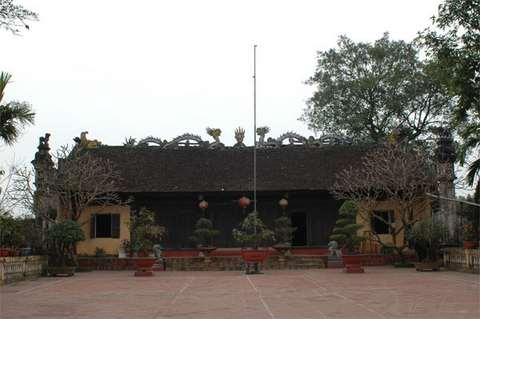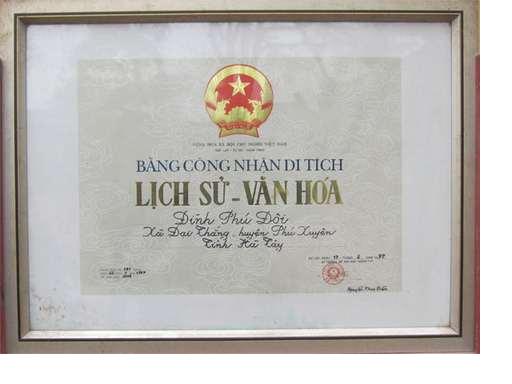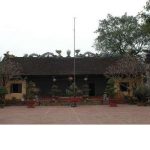
Present-day Phu Doi communal house
Phu Doi is a Vietnamese village from ancient times of a large population relying mainly on agriculture. Phu Doi village was firstly named Dong Nhuyen site (later called Nhon) within Luong Xa canton, Phu Van district, Son Nam town, nowadays within Dai Thang commune, Phu Xuyen district, Hanoi City. The village has a communal house and a pagoda which have been recognized as National Historical-Cultural Relic Sites. Phu Doi Communal House worships Nam Giang King, who distributed the land, helping the Dong Nhuyen site expand its area and became more prosperous. According to the legend of Thanh Hoang (equivalent to a Lord) of Phu Doi village, the 41st son of Lac Long Quan and Au Co was assigned to manage Nam Giang district, and was called Nam Giang Vuong. In one visit of Nam Giang Vuong to Dong Nhuyen site in Phu Van district, he saw a land plot, in the front of which there was a very deep water channel leading to a small pond, which is covered by stars. Behind the land, there was a soil mound symbolizing the dragon body. There were also a reverse flowing water, and other surrounding flows of water. Being aware that living on this land will bring not only much wealth but also prominent descendants, Vuong decided to build up the site according to Northwest – Southeast direction, rewarded the elderly in the site, and bought more land for the future. Vuong then returned to manage the county.
According to the old people of the village, Phu Doi communal house was established several hundred years ago. Initially, the communal house was temporarily built in the middle of the village, and then moved toward the beginning of the village.
The current communal house at the beginning of the village was built in 1923, having the shape of the mallet handle, consisting of the major area and the sanctuary area. In the major area, there are 5 compartments and 2 arms on both sides adjacent to the wall. There are 4 rows of pillars, each of which has 6 pillars, in which 4 pillars in the middle area are made of stone, and the remaining pillars are made of precious wood. In the sanctuary area, there are 4 pillars made of precious wood. In the innermost, ancestral tablet is placed on an edicule. There were 2 ancient horizontal lacquered boards: the big one placed in the middle has 4 big-character words: Dai Duc Xuyen Luu. Also, there are 2 ancient parallel sentences. 2 areas for meeting are placed on both sides of the yard (later used as temporary classrooms). On the road in front of the house, there is a drinking water well, of which wall has been currently built from the bottom up for the purpose of preserving the well and creating a more spacious and beautiful area. Elderly people said that this communal house was initially facing north, and a pen holder tower is erected on the right side of the house. However, fires often occur in Xuan La village area in the north of Phu Doi communal house. It was thought by Xuan La old villagers that feng shui – based arrangement. Xuan La old villagers then requested to rebuild Phu Doi communal village and change its main direction, and obtained the consent of Phu Doi old villagers. After Phu Doi communal house was rebuilt facing the south, fires no longer occur in Xuan La village. From then on, the 2 villages are closer to each other.
However, due to the direction change, the pen holder tower is located on the left side. It may be the reason for few talents in Phu Doi. There is no trace of the pen holder tower now.
Talking about Nam Giang Vuong, after building the house, helping the villagers to build beautiful facilities, he returned to the District to take care of the public affairs. When he was 103 years old, he died in Dong Dinh on the 10th of lunar March. After that, Dong Nhuyen asked the imperial court for worshipping him. As agreed by the imperial court, the elderly went to the imperial city to receive the honour document and started worshipping since then. Hung King at that time made a mistake to call him Nam Giang Vuong, gave him six beautiful letters and three units of money and added him into the ceremonies of the State. He became a supreme god.
In addition to Phu Do communal house, there are 23 temples nationwide allowed to worship Nam Giang Vuong. Through the dynasties, Nam Giang Vuong – Phu Doi village’s god was awarded 13 honour documents which have been solemnly kept at the communal house.

To show gratitude to Nam Giang Dai Vuong, every year, Phu Do villagers organize the traditional festival on the 10th of lunar March – his death date. Phu Doi communal house was recognized as a historic – cultural monument by the former Ministry of Culture and Information (under the Decision No. 141 – QD/VH dated January 23rd, 1997).
Quynh Anh

